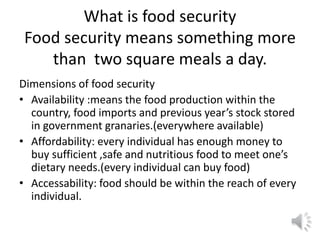Food security means ensuring all people have access to sufficient, affordable and nutritious food. Key aspects of food security are availability, affordability and accessibility of food. India established its public food distribution system and buffer stocks after the 1943 Bengal famine to ensure food security, especially for poor and vulnerable groups. The system involves government procurement of food grains from farmers at minimum support prices, storage by the Food Corporation of India, and distribution of grains at subsidized prices through ration shops under public distribution system. However, there are also challenges like overflowing storage while some lack food, illegal diversions of grains, and environmental impacts of certain crop choices.


















